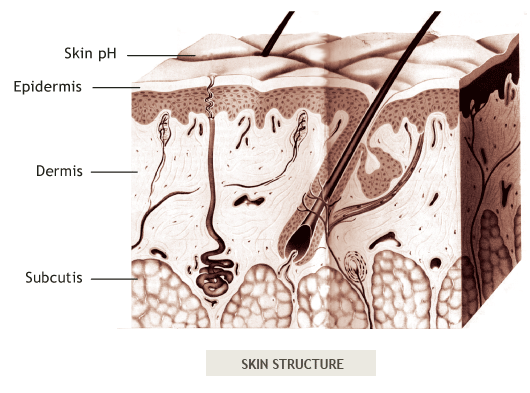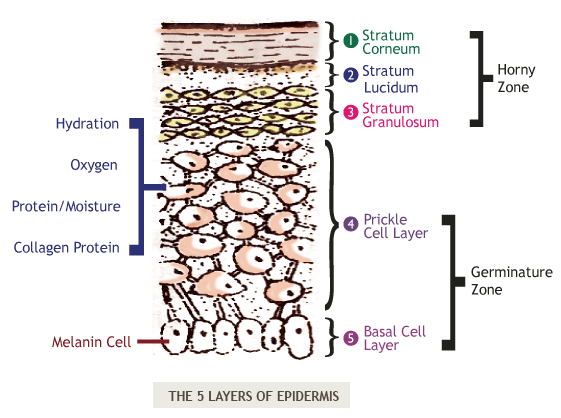Know the Skin
The human skin is the elastic, soft and strong protection layer covering the whole body . It is the largest organ of the integumentary system. Skin is composed of three primary layers: the epidermis, the dermis, and the hypodermis (subcutaneous adipose layer).

The outermost layer of the skin is epidermis. Epidermis is again divided into 5 sublayers: the Horny Layer(Stratum Corneum), Clear Layer (Stratum Lucidum), Granular Layer (Stratum Granulosum), Spinous Layer(Stratum Spinosum) and Basal Layer (Stratum Basale).
Skin plays a key role in protecting the body against pathogens and excessive water loss. It take 14 days for cells generated at the basal layer through mitosis to reach to the top layer, another 14 days for horny layer to slough off. The whole process takes about 28 days and it is called keratinization.

- Horny Layer
(Stratum Corneum) - This is the outermost layer of the skin. It consists of thin, flat, dead squamous cells whose protoplasm has been changed into a horny substance called keratin. They have completely lost or lack of nuclei and organelle which consequently slough off. Cells of Stratum Corneum contain a dense network of keratin, a protein that helps keep the skin hydrated and elastic.
- Clear Layer
(Stratum Lucidum) - It is a thin, clear layer of dead skin cells in the epidermis named for its translucent appearance under a microscope. It is found only in areas of thick skin, most noticeably on the palms of the hands and the soles of the feet.
- Granular Layer
(Stratum Granulosum) - The granular layer is a thin layer of cells in the epidermis. Keratinocytes migrating from the underlyingstratum spinosum become known as granular cells in this layer. These cells contain keratohyalin granules, protein structures that promote hydration and crosslinking of keratin.
- Prickle-cell Layer
(Stratum Spinosum) - The Prickle-cell Layer is found between Granular Layer and Basal Layer. This prickly appearance is due to desmosomal connections of adjacent cells. Keratinization begins in the stratum spinosum.
- Basal Layer
(Stratum Basale) - The stratum basale (basal layer, sometimes referred to as stratum germinativum) is the deepest layer of the five layers of the epidermis. The stratum basale is primarily made up of basal keratinocyte cells. They divide to form the keratinocytes of the stratum spinosum, which migrate superficially. Other types of cells found within the stratum basale are melanocytes (pigment-producing cells), Langerhans cells (immune cells), and Merkel cells (touch receptors).



